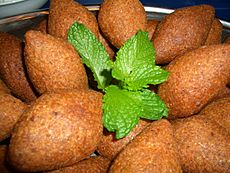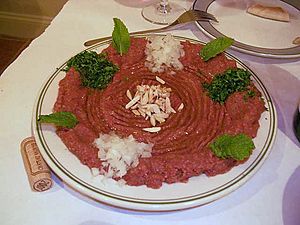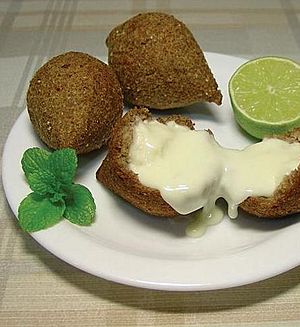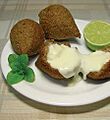Kibbeh facts for kids

Fried kibbeh raas (nabulsi kibbeh)
|
|
| Course | Meze |
|---|---|
| Region or state | Levant, Mesopotamia |
| Serving temperature | Hot |
| Main ingredients | Finely ground meat, cracked wheat, and Middle Eastern spices |
Kibbeh (pronounced KIB-ee) is a delicious family of dishes from the Middle East. It's usually made with spiced ground meat, onions, and a type of grain.
In the Levant (a region in the Middle East), kibbeh is often made by pounding bulgur wheat with meat. This creates a smooth paste. People then shape it into balls and add toasted pine nuts and spices.
You can cook kibbeh in many ways. It can be baked in layers on a tray. It can also be deep-fried or grilled. Some types of kibbeh are even served raw. In Iraq, some kibbeh recipes use rice or farina instead of bulgur. Some recipes also add semolina.
Kibbeh is a very important dish in Lebanon and Syria. It's popular throughout the Levant. You can find different versions of kibbeh in many countries. These include Cyprus, Egypt, Israel, Iraq, Iran, Armenia, and Turkey. It's also popular in Latin America and North America. This is because many people from the Levant moved there a long time ago.
Contents
What Does "Kibbeh" Mean?
The words kibbeh and kubba come from an Arabic word. That word is kabbaba. It means "to form into a ball." This is why it's related to the word "kebab".
Different Kinds of Kibbeh
Kibbeh in the Middle East
In the Levant, many dishes made with bulgur (cracked wheat) and minced lamb are called kibbeh. The city of Aleppo in Syria is famous for its many types of kibbeh. It has more than 17 different kinds!
Some types include kibbeh with sumac (a tangy spice). Others are made with yogurt or quince (a fruit). There's also kibbeh with lemon juice or pomegranate sauce. Some even have cherry sauce.
There are also "disk" kibbeh, which are flat and round. "Plate" kibbeh are baked in a tray. And then there's raw kibbeh, called kibbeh nayyeh.
Kibbeh nayyeh is a raw dish. It's made from bulgur and very finely minced lamb or beef. It's like a Middle Eastern version of steak tartare. It's served on a platter, often as part of a meze (a selection of small dishes). People in Lebanon and Syria often eat it. It's usually decorated with mint leaves and olive oil. It's served with green onions and pita bread. Because kibbeh nayyeh is raw, it needs very good quality meat. Serving it is a traditional way to honor guests.
Kubba Mosul from Iraq is flat and round like a disc. Kubba halab is an Iraqi kibbeh made with a rice crust. It's named after the city of Aleppo in Syria. Kubbat Shorba is an Iraqi and Kurdish kibbeh. It's prepared as a stew, often with tomato sauce. People often eat it with arak (a drink) and different salads.
There's a Syrian soup called kubbi kishk. It has kubbi "footballs" in a yogurt and butter broth. It also has stewed cabbage leaves. Another soup is kibbeh hamda. It's made with chicken stock and vegetables. These usually include leeks, celery, turnips, and zucchini. It also has lemon juice and garlic. Small kibbeh made with ground rice are added like dumplings.
Kibbeh in South America
On Colombia's Caribbean coast, local versions of kibbeh often use ground beef. The original recipe with lamb, or a mix of beef and lamb, is also found. This is thanks to the many Middle Eastern families who live there. Kibbeh is very popular and often served at parties. It's a common starter dish, along with other local treats like empanadas.
In Brazil, kibbeh is called quibe or kibe. It's often stuffed with catupiry or requeijão. These are soft cheeses similar to ricotta. Most Brazilian kibbeh only use ground beef. Other versions might use tahini (sesame paste) or soy protein. Some even use wheat gluten or tofu as a filling.
Some Jewish communities in Latin America mix kibbeh with local foods. For example, Syrian Jews in Mexico often eat traditional kibbeh with salsa verde.
Images for kids
See also
 In Spanish: Kibbe para niños
In Spanish: Kibbe para niños






